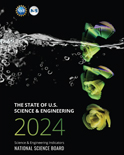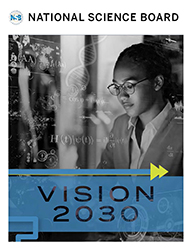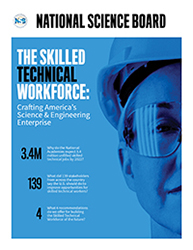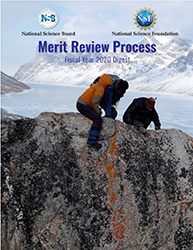
New report shows we must do more to include “Missing Millions” in science and engineering

Race and ethnicity of U.S. population ages 20-34 and S&E award recipients, by degree level: 2021 (Credit and Larger Version)
November 16, 2023
Between 2012 and 2021, the number of U.S. postsecondary science and engineering awards increased across all degree levels and among Black or African American and Hispanic or Latino student groups, which historically have been underrepresented in attaining those degrees. American Indian or Alaska Native students, also underrepresented, received fewer science and engineering degrees in 2021 than they did in 2012.
These and similar trends are in the Higher Education in Science and Engineering report that the National Science Board published today as part of the 2024 congressionally mandated Science and Engineering Indicators suite of products on the state of the U.S. science and engineering enterprise. The reports are prepared by the U.S. National Science Foundation’s National Center for Science and Engineering Statistics under the Board’s guidance.
“It’s clear we are not moving fast enough to reach the “Missing Millions” in STEM, in spite of the fact that more students are studying science and engineering,” Heather Wilson, President of the University of Texas at El Paso and National Science Board Member, said.
The Board’s Vision 2030 highlights the urgency of reaching those “Missing Millions” by calling for women and other underrepresented groups to have greater representation in the U.S. science and engineering enterprise and help meet the country’s STEM workforce needs.
The new report shows where the nation is on reaching those goals. The report includes trends by scientific field, degree level, demographics, type of institution (including for-profit institutions and community colleges), and international students in the U.S. and students in other countries. It also covers minority-serving institutions, intuition location, higher education cost, and student debt.
Highlights include:
- Overall, science and engineering degree awards at all levels continued long-term trends of gradual increases during the COVID-19 pandemic, although doctoral degrees slightly decreased from 2020 to 2021.The percent of all doctorates awarded in science and engineering fields didn’t change but remained the highest at 66%.
- Growth in engineering and computer and information sciences degrees accounted for much of the increase in total science and engineering degrees awarded at most levels.
- The number of science and engineering certificates and degrees earned by students from most racial and ethnic groups has grown at most award levels over the last decade. Hispanic students’ associate, bachelor, and advanced degrees increased by the greatest number from 2012 to 2021.
- However, as of 2021, American Indian or Alaska Native, Black or African American, and Hispanic students were underrepresented among science and engineering certificate and degree award recipients at most award levels relative to their proportions of the U.S. population that was 20-34 years old.
- As of 2021, women earned more than 50% of science and engineering awards in the agricultural and biological sciences, multidisciplinary and interdisciplinary sciences, psychology, and social sciences. On the other hand, women remained underrepresented among award recipients in fields like engineering and computer and information sciences.
- In 2021, most associate degrees in science and engineering, and related fields, were awarded by community colleges. The most popular field of study for these credentials was health professions and related programs.
- Despite many institutions and students returning to in-person instruction, the pandemic has continued to affect postsecondary enrollment, student learning and well-being, institutional finances, and workforce development. There were nearly 1.4 million fewer undergraduates enrolled in 2022 than before the pandemic, a 9.4% decline. Community colleges’ enrollment fell by 351,000 students, a 7.8% decline, between 2021 and 2022.
- The largest number of doctoral degree recipients in 2021 studied engineering, followed by health sciences and then biological and biomedical sciences. For master’s degree recipients, computer and information sciences were the most popular fields, followed by engineering and then psychology. For bachelor’s degree recipients, social sciences degrees were the most common fields, followed by psychology and then biological and biomedical sciences.
- Surpassing pre-COVID pandemic levels, enrollment of international science and engineering graduate students studying in the United States increased rapidly from about 196,000 in fall 2020 to 308,000 in fall 2022.
- In 2020, India awarded the most science and engineering first university degrees (2.5 million), followed by China (2.0 million) and then the United States (900,000). China awarded the highest number of doctoral degrees (43,000), followed closely by the United States (42,000), which China surpassed in 2019.
Higher Education in Science and Engineering is the third of 10 Science and Engineering Indicators reports that the NSB will publish over the coming months through spring of 2024. It builds on the Elementary and Secondary STEM Education Report, which focused on quantifying the COVID-19 pandemic’s impact on K-12 student progress.
About Science and Engineering Indicators
Science and Engineering Indicators is a congressionally mandated report on the state of the U.S. and international science and engineering enterprise. Indicators provides high-quality quantitative information on the enterprise in a series of reports and a data tool that provides state-level data.
About the NSB
The National Science Foundation Act of 1950 charged the NSB with two roles: to be the governing board of the NSF and an advisor to Congress and the President on policy matters related to STEM research and STEM education. Selected for their distinguished service and accomplishments in academia, government, and the private sector, the Board’s 24 presidentially appointed members are leaders in STEM research and education.
About the NCSES
NSF’s National Center for Science and Engineering Statistics (NCSES) is the nation's leading provider of statistical data on the U.S. science and engineering enterprise. As a principal federal statistical agency, NCSES serves as a clearinghouse for the collection, interpretation, analysis, and dissemination of objective science and engineering data.
Media Contact: Elizabeth Jeffers, National Science Board, (703) 292-7496, ejeffers@nsf.gov
The U.S. National Science Foundation propels the nation forward by advancing fundamental research in all fields of science and engineering. NSF supports research and people by providing facilities, instruments and funding to support their ingenuity and sustain the U.S. as a global leader in research and innovation. With a fiscal year 2023 budget of $9.5 billion, NSF funds reach all 50 states through grants to nearly 2,000 colleges, universities and institutions. Each year, NSF receives more than 40,000 competitive proposals and makes about 11,000 new awards. Those awards include support for cooperative research with industry, Arctic and Antarctic research and operations, and U.S. participation in international scientific efforts.
Useful NSB Web Sites:
Home Page: http://www.nsf.gov/nsb
Media Contact: http://www.nsf.gov/staff/staff_bio.jsp?lan=nlymn&org=NSF
News: http://www.nsf.gov/nsb/news
Meetings: http://www.nsf.gov/nsb/meetings
Publications: http://www.nsf.gov/nsb/publications
Facebook: https://www.facebook.com/NationalScienceBoard
Twitter: https://twitter.com/NSF_NSB
YouTube: https://www.youtube.com/channel/UCkrHRzuGSrPp2haQs0T_Pww
The U.S. National Science Foundation propels the nation forward by advancing fundamental research in all fields of science and engineering. NSF supports research and people by providing facilities, instruments and funding to support their ingenuity and sustain the U.S. as a global leader in research and innovation. With a fiscal year 2023 budget of $9.5 billion, NSF funds reach all 50 states through grants to nearly 2,000 colleges, universities and institutions. Each year, NSF receives more than 40,000 competitive proposals and makes about 11,000 new awards. Those awards include support for cooperative research with industry, Arctic and Antarctic research and operations, and U.S. participation in international scientific efforts.
Useful NSB Web Sites:
Home Page: http://www.nsf.gov/nsb
Media Contact: http://www.nsf.gov/staff/staff_bio.jsp?lan=nlymn&org=NSF
News: http://www.nsf.gov/nsb/news
Meetings: http://www.nsf.gov/nsb/meetings
Publications: http://www.nsf.gov/nsb/publications
Facebook: https://www.facebook.com/NationalScienceBoard
Twitter: Twitter: https://twitter.com/intent/user?screen_name=NSF_NSB
YouTube: https://www.youtube.com/channel/UCkrHRzuGSrPp2haQs0T_Pww
To view PDF documents, please download Adobe Acrobat Reader.
Useful NSB Web Sites:
Home Page: http://www.nsf.gov/nsb
Media Contact: http://www.nsf.gov/staff/staff_bio.jsp?lan=nlymn&org=NSF
News: http://www.nsf.gov/nsb/news
Meetings: http://www.nsf.gov/nsb/meetings
Publications: http://www.nsf.gov/nsb/publications
Facebook: https://www.facebook.com/NationalScienceBoard
Twitter: Twitter: https://twitter.com/intent/user?screen_name=NSF_NSB
YouTube: https://www.youtube.com/channel/UCkrHRzuGSrPp2haQs0T_Pww
To view PDF documents, please download Adobe Acrobat Reader.




